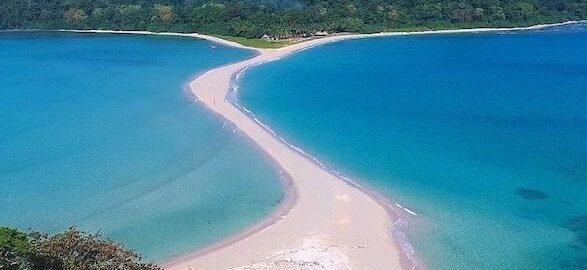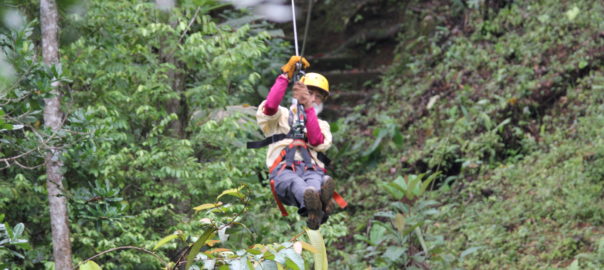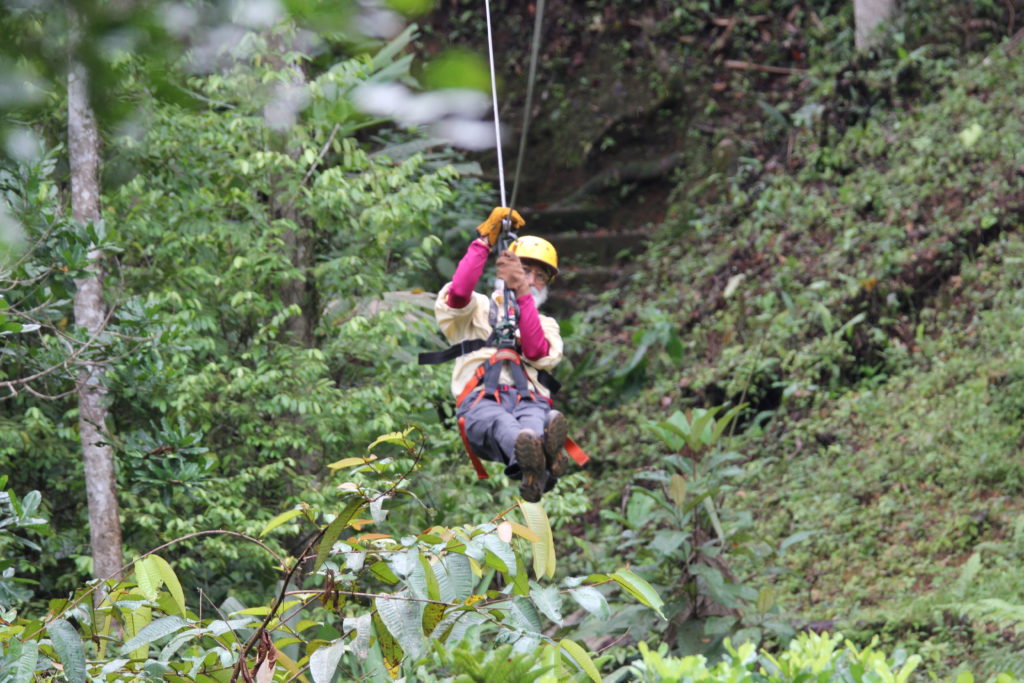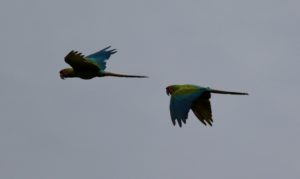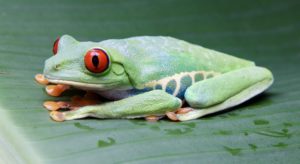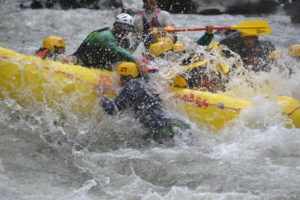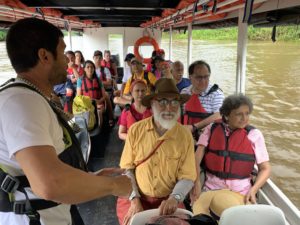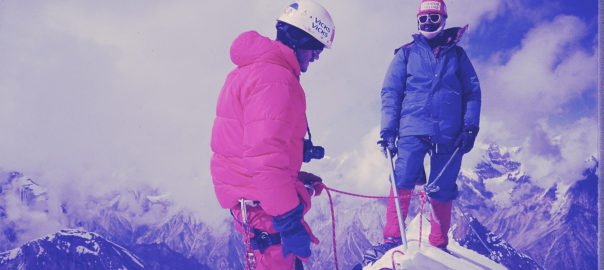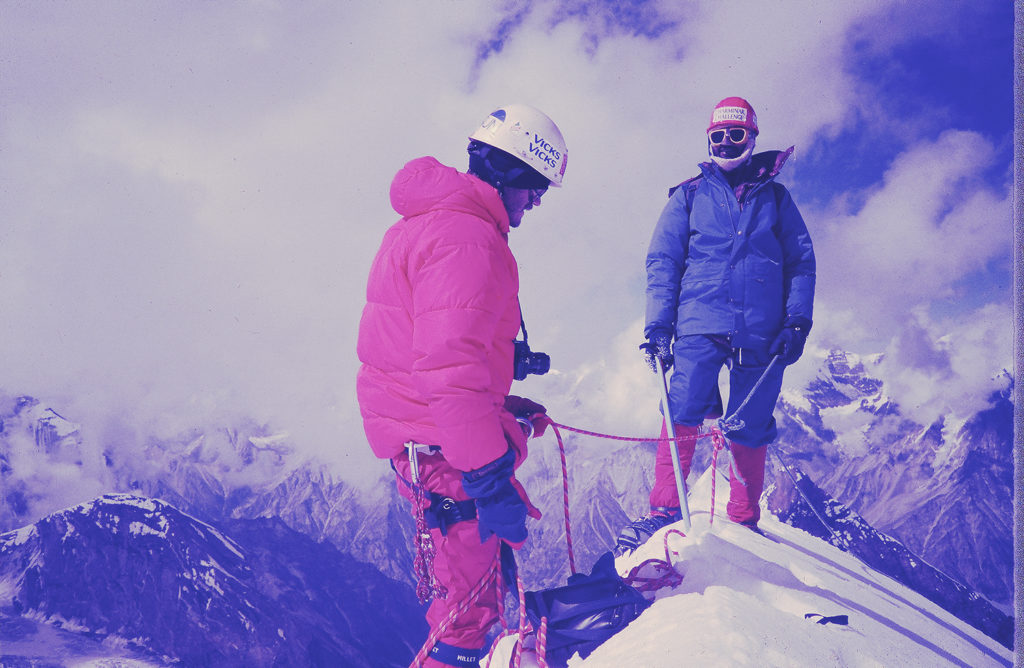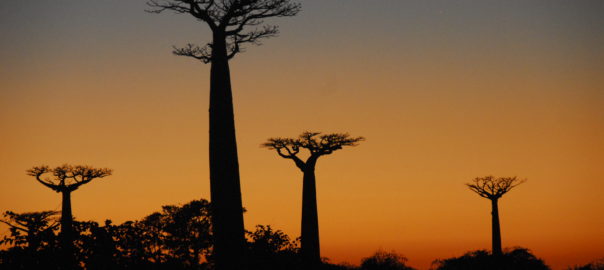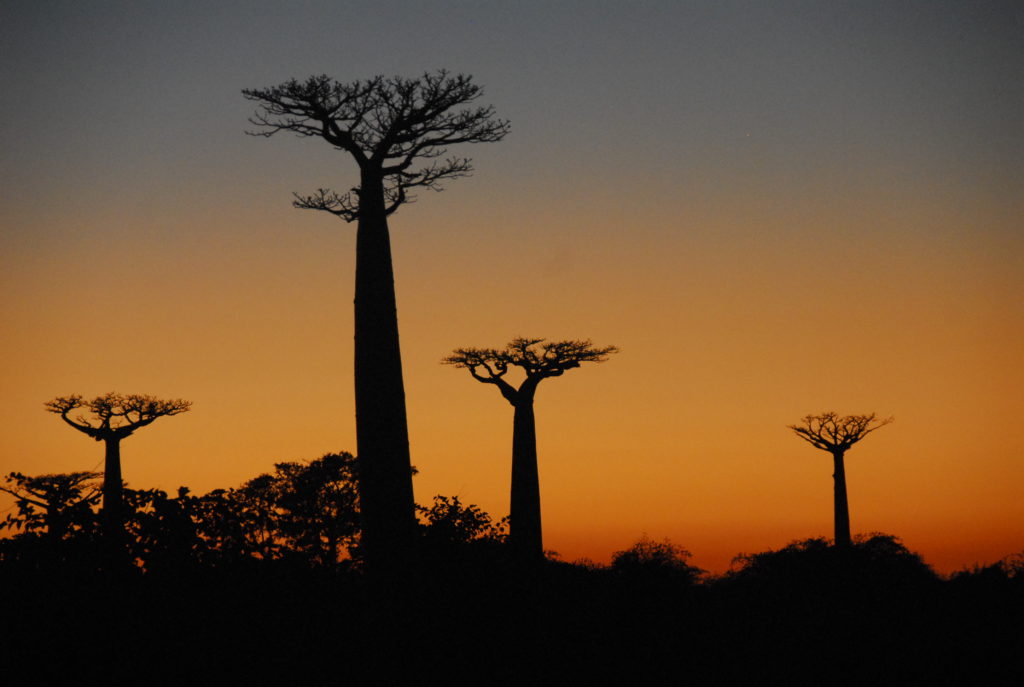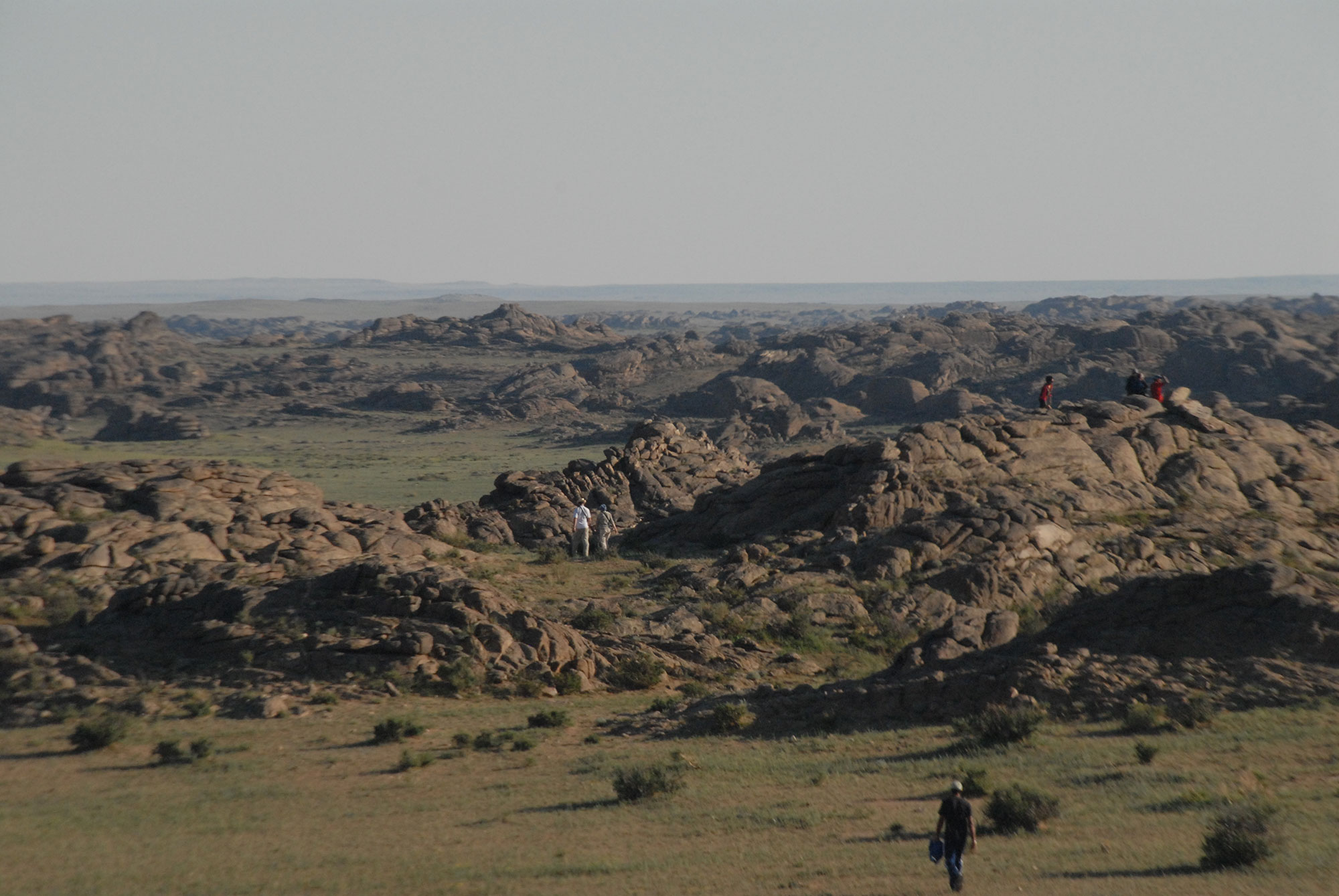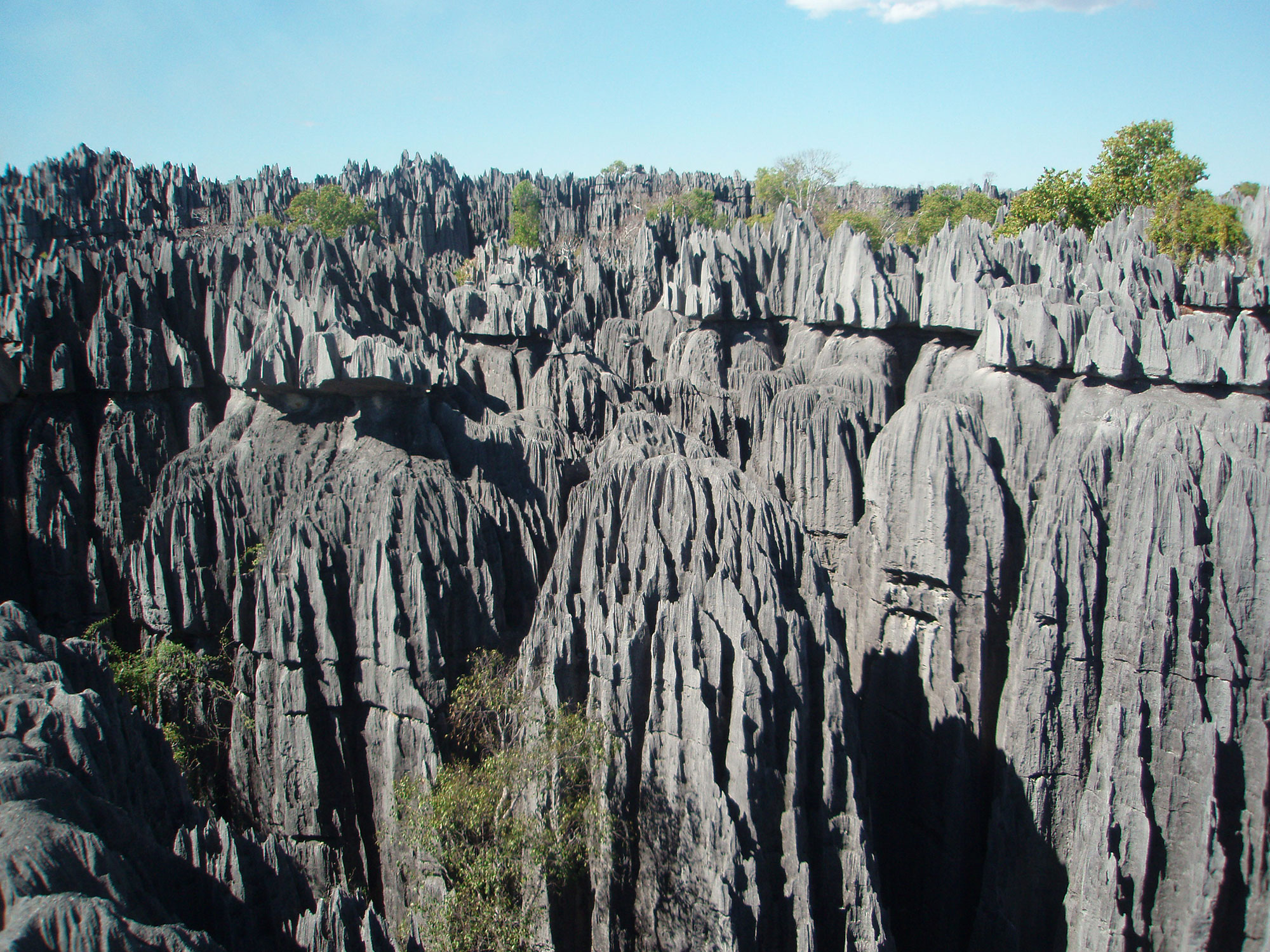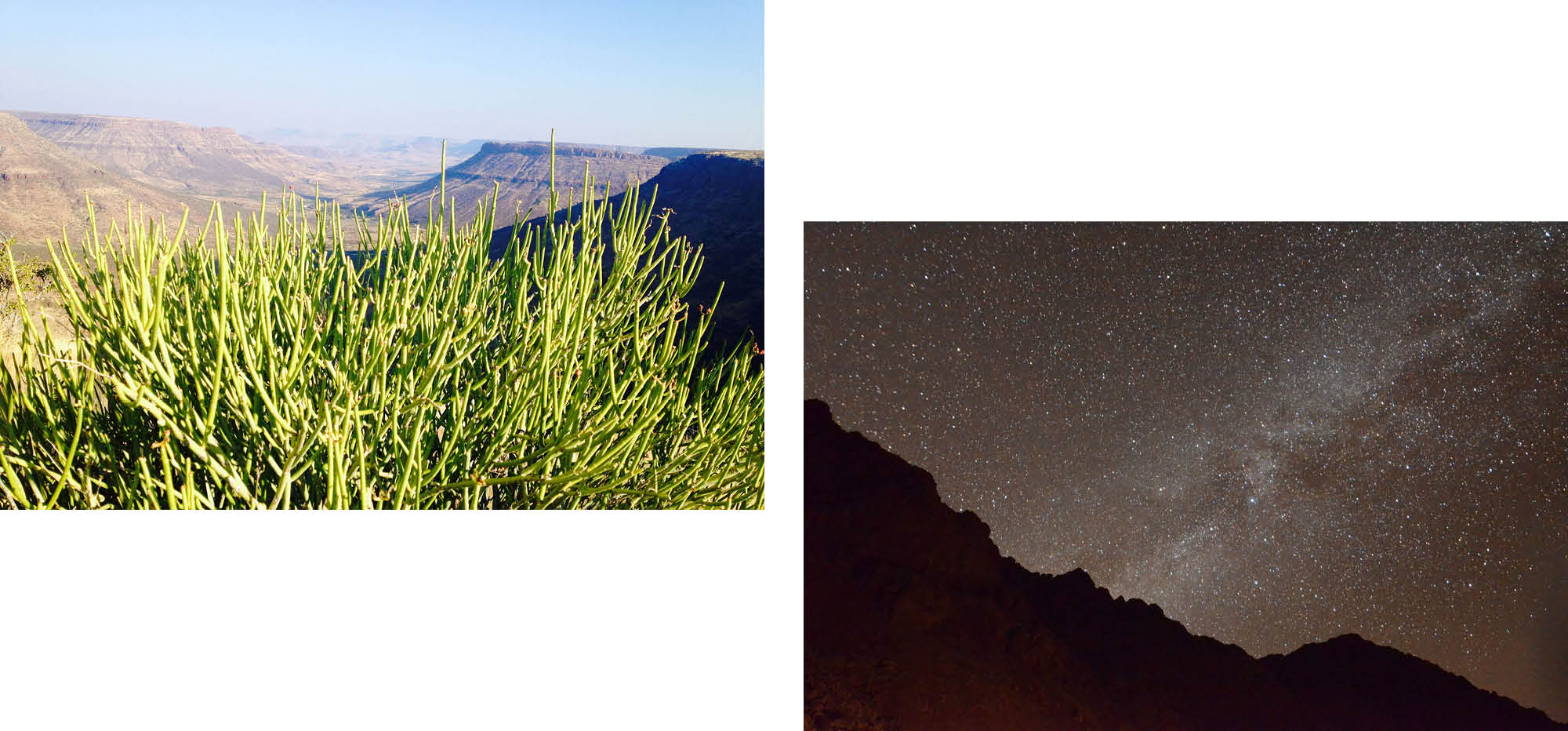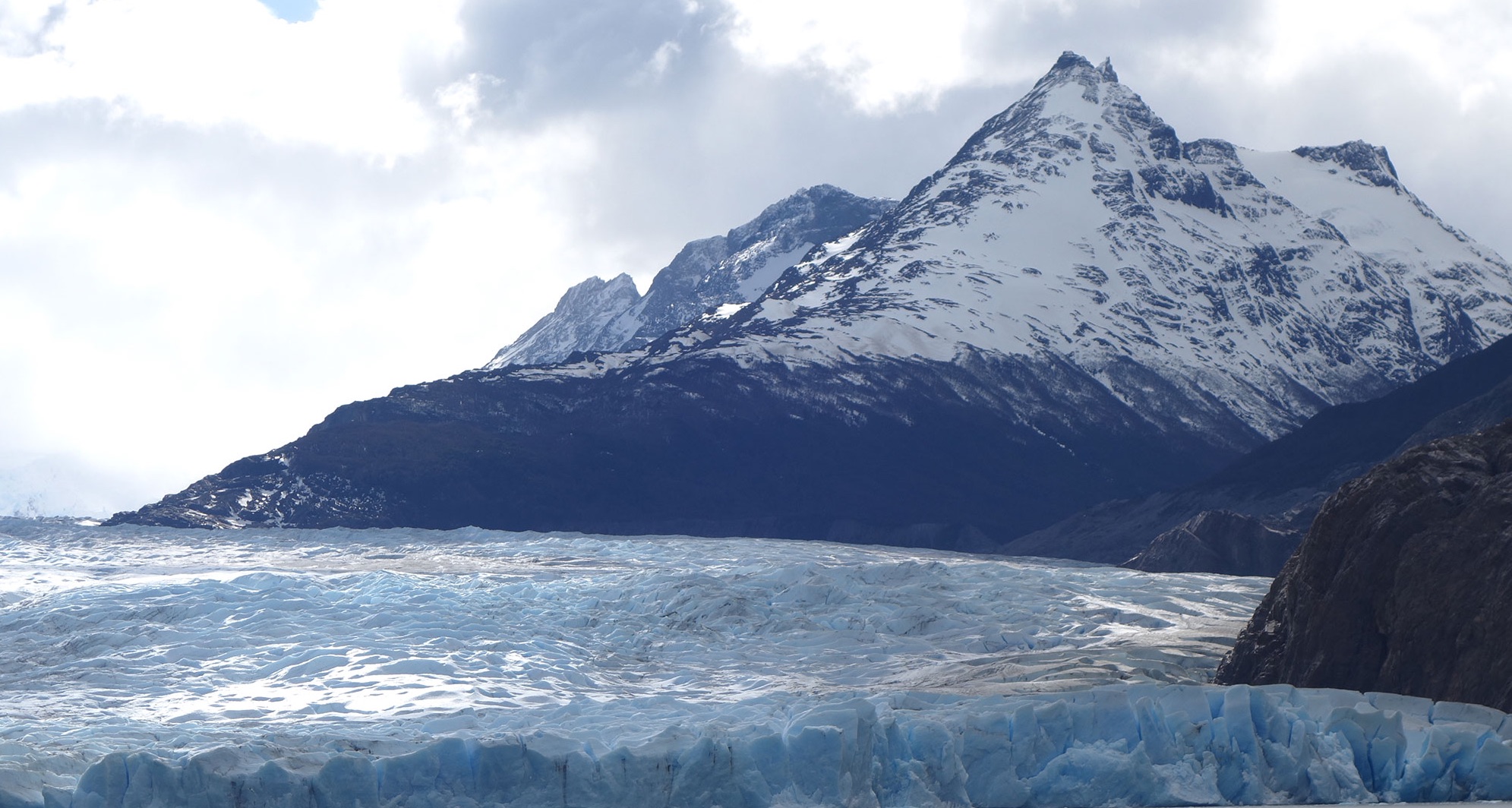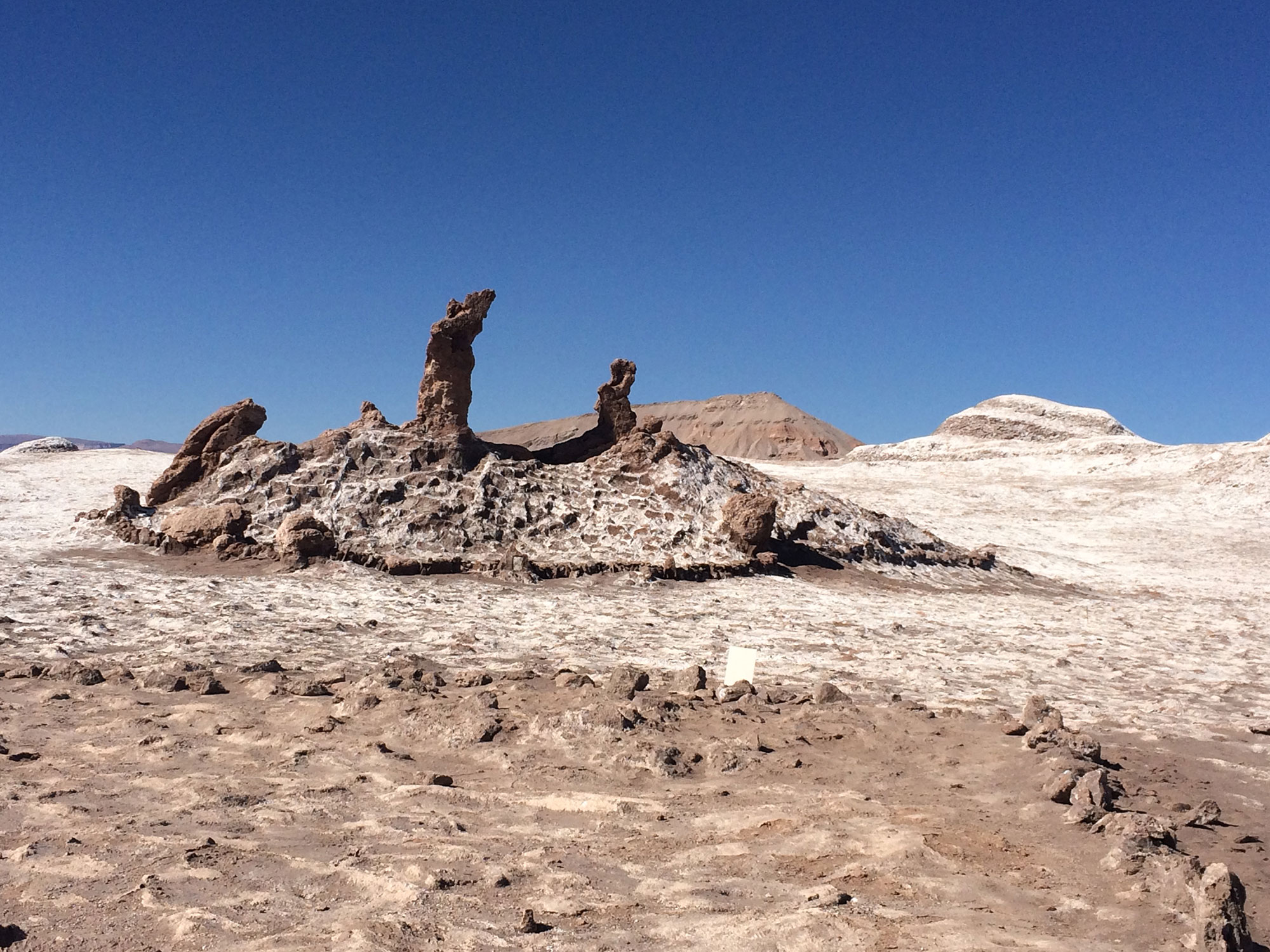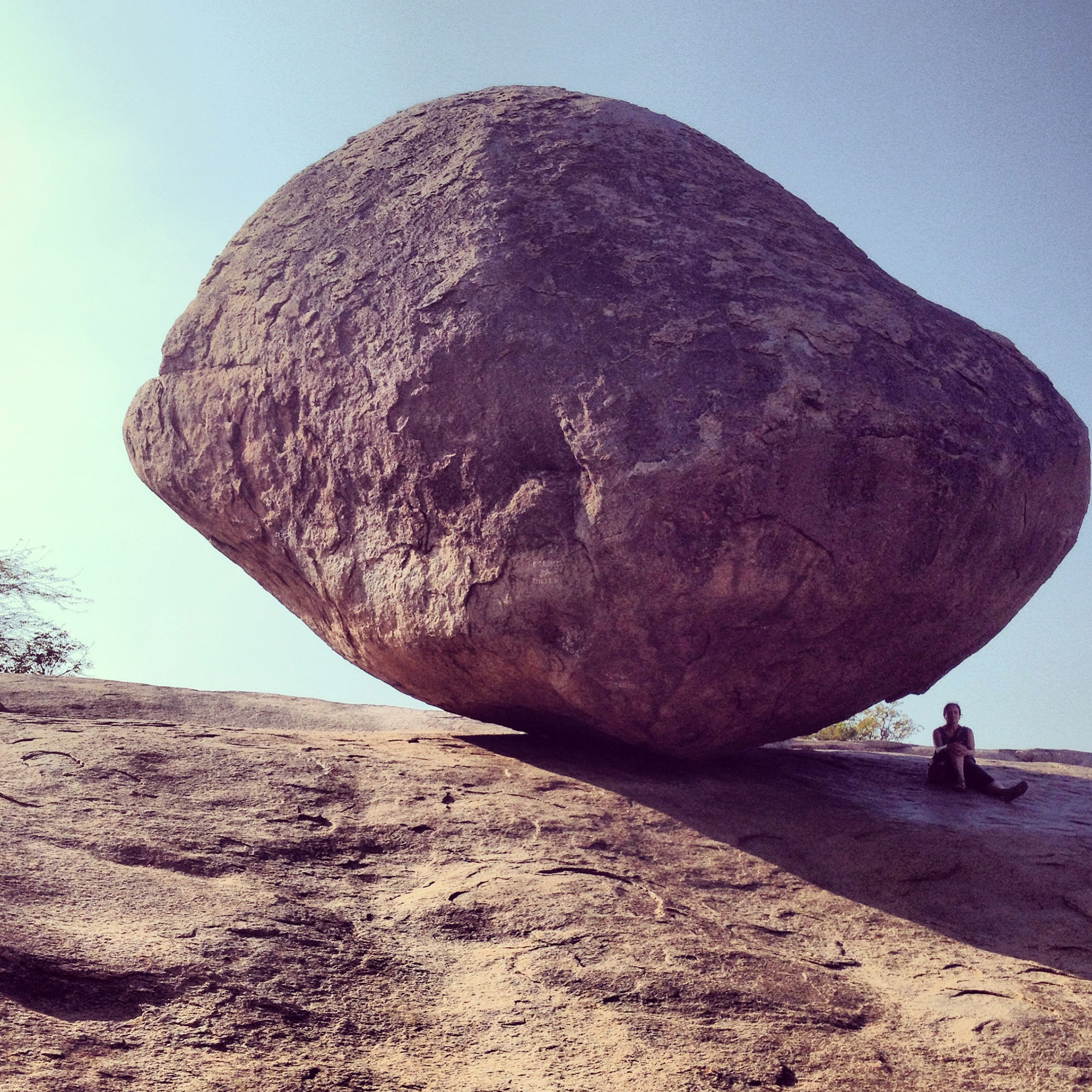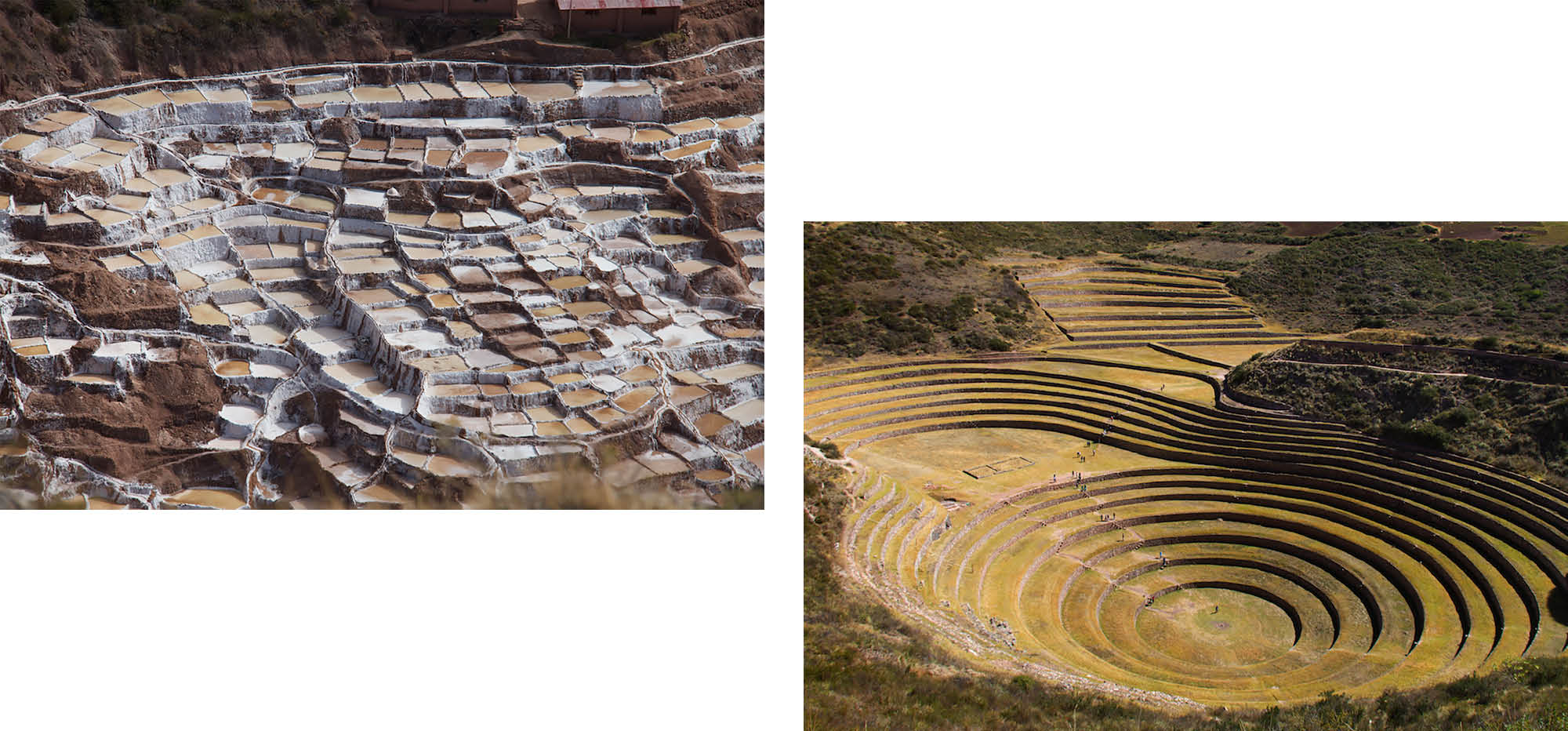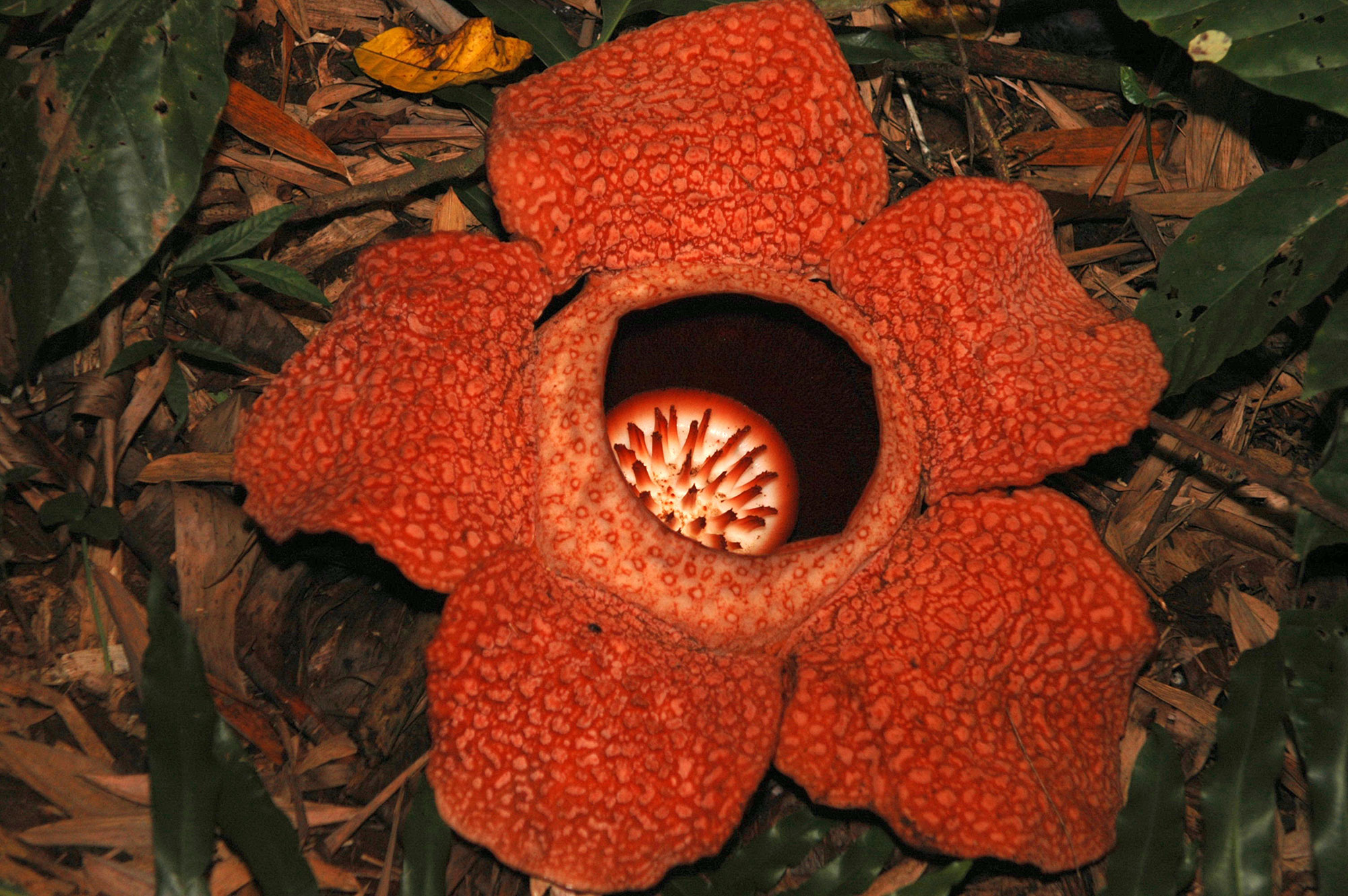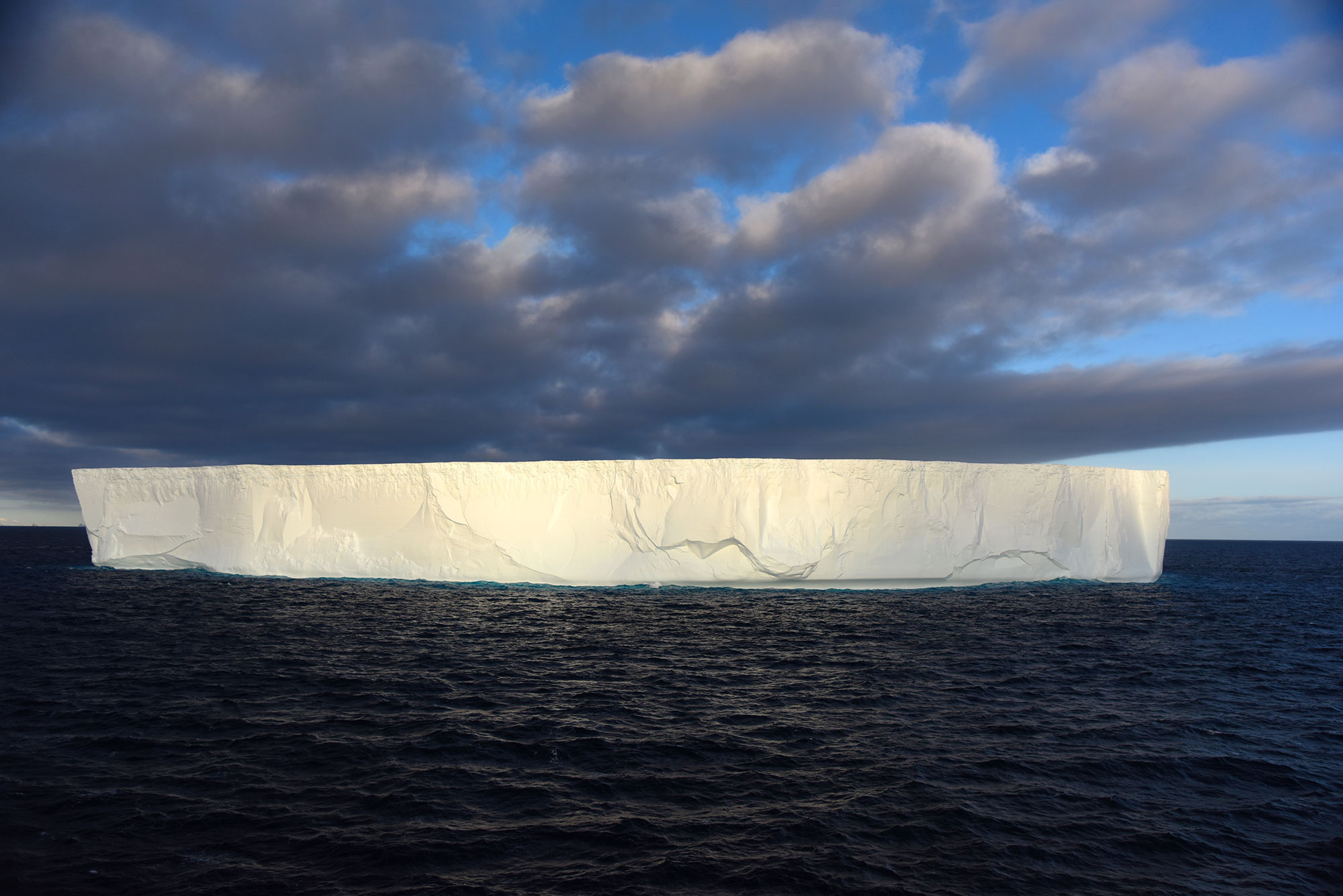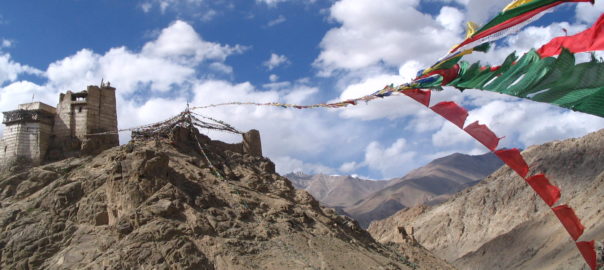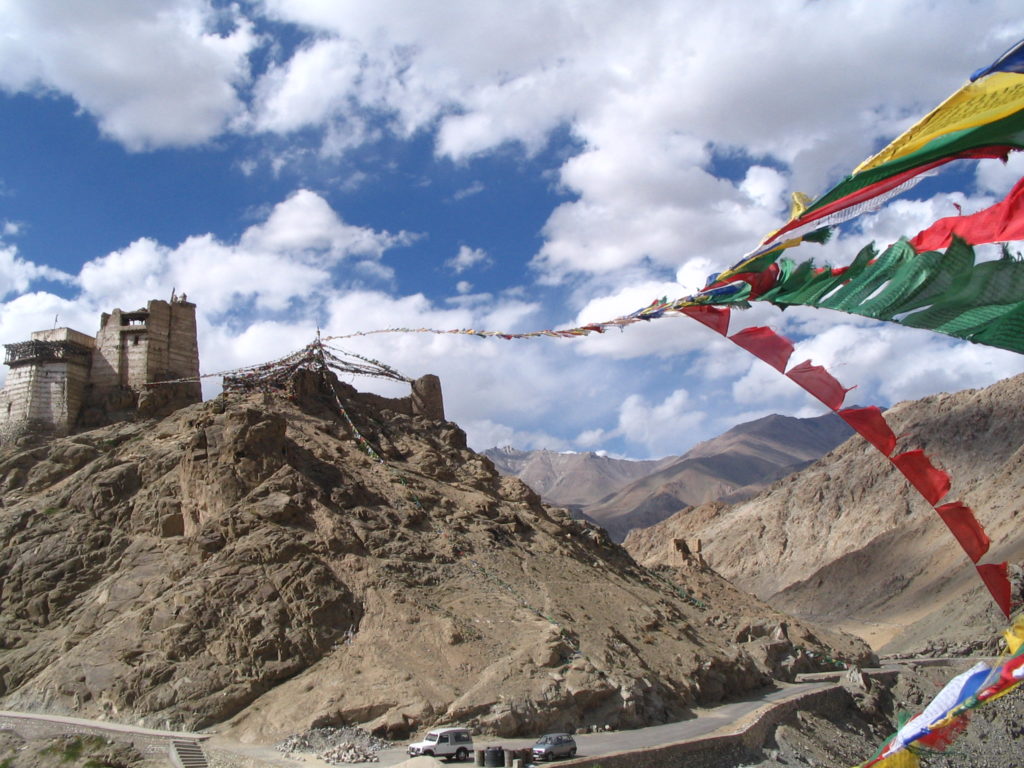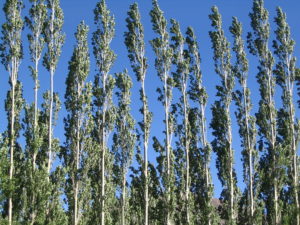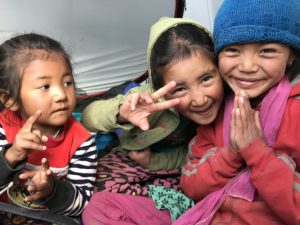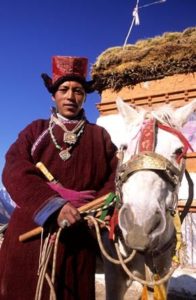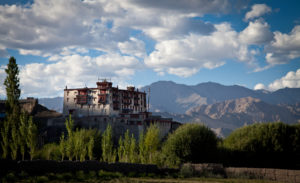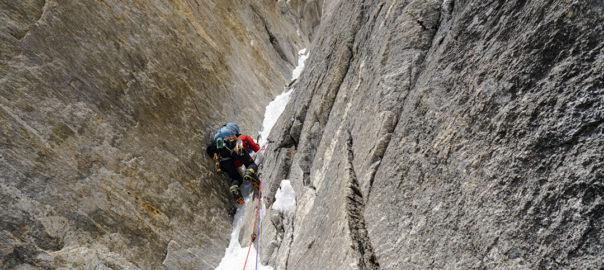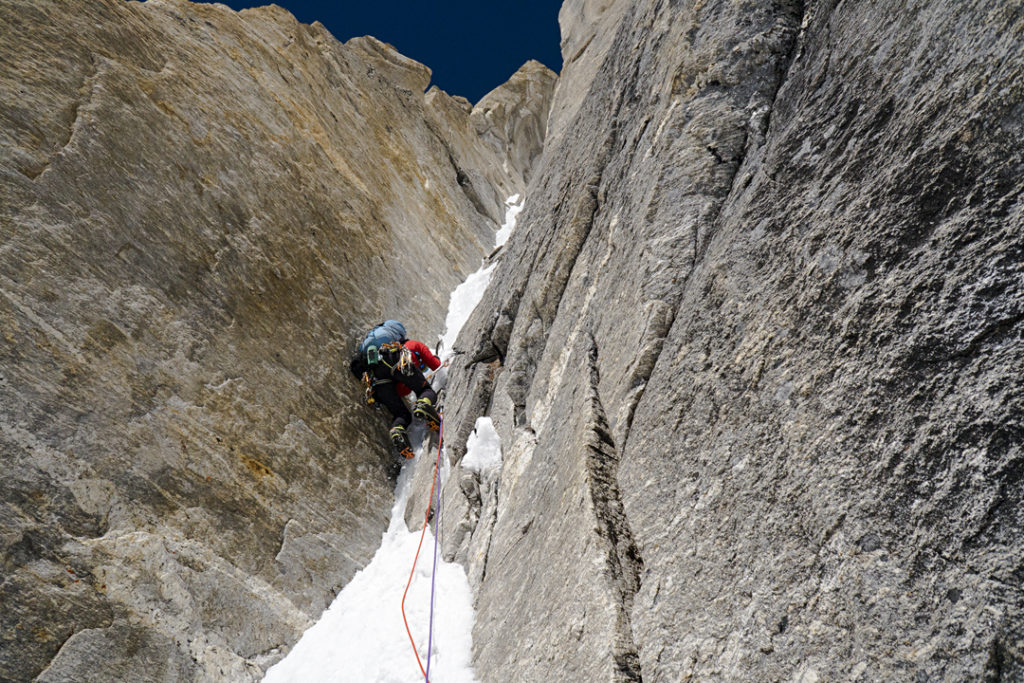Journey Leader: Himraj Soin
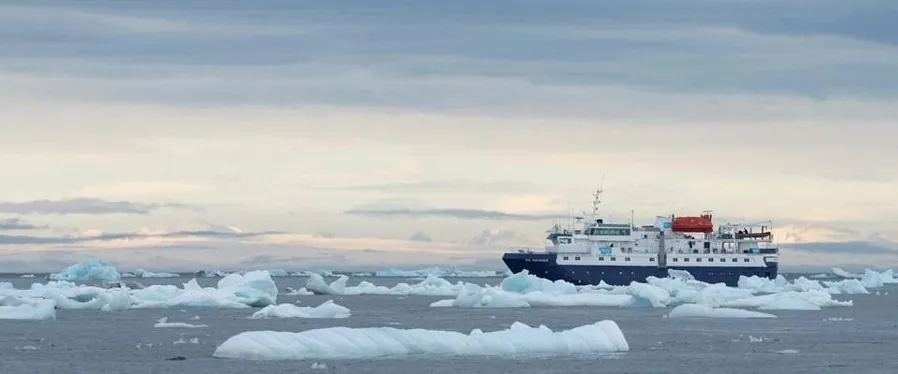
THE EXPEDITION CRUISE
Our 51-member Arctic 2023 expedition cruise returned after a successful trip in May, accompanied by Mandip Singh Soin and Himraj Soin. Our 2024 journey was led by Himraj Soin.
The team braved the sub-zero temperatures and sailed along the western fjords of Svalbard, reaching 79.65 degrees North and mailed postcards from the world’s northernmost settlement at Ny Ålesund.
In the realm of the midnight sun, through sparkling ice formations, snowcovered mountains, fjord ice, they made their way in sturdy zodiac boats, dressed in polar suits, and had multiple sightings of polar bears, Arctic fox, reindeer, king eider ducks, puffins, rock ptarmigan, minke whales, ringed seals, and walruses.
They watched the archipelago come to life as they weaved through ice flows and glaciers that were calving, due to global warming.
The group was international, and the cuisine catered to all types of nonvegetarians, vegetarians, and vegans.
The polar bear is a threatened species due to the loss of sea ice habitat, climate change and trophy hunting in certain countries. The Ibex Expeditions Arctic team is joining us to launch an awareness campaign to ‘Save the Polar Bear’ with conservation organizations and every member of the expedition has pledged to be an advocate for this campaign.
We expect to have a similar immersive experience with the 2025 participants and the participants will pledge to join this initiative.
High points:
▪ Experience the Arctic Spring and stunning winter landscapes.
magical midnight sun with 24 hours of daylight!
▪ Visit the 3 historic polar/adventure museums in Oslo—the Fram, Viking, and Kon Tiki—on May 11, 2025 afternoon.
▪ Welcome dinner in Oslo on May 11, 2025.
▪ Best time for Polar bear and King Eider sightings.
▪ Expedition cruising in a small expedition vessel with 50 passengers
▪ Experienced naturalist outdoor guides.
▪ Daily zodiac rides
▪ Lectures and knowledge sharing in this region
▪ Possibility of short hikes or snowshoeing.
▪ Polar plunge into the icy waters (optional but fun).
▪ Possible landing or visit to the northernmost settlement in the world
▪ Doctor on board
▪ The trip is 100% climate-compensated.
Length: 9 days—1 night in Oslo (11th May 2025), 1 night in Longyearbyen (12th May 2025), and 7 nights on the ship (13th–20th May 2025).
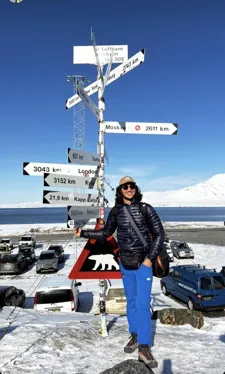
Himraj Soin—Journey Leader
Himraj is Co-Founder and Producer at The Outdoor Journal and leads journeys for Ibex Expeditions.
He writes and shoots for international travel destinations, conservation issues, extreme adventure sports, athletes, gear, and more. His work has been published in Vogue, National Geographic Traveller India, Reader’s Digest UK, and Conde Nast Traveller.
An avid skier and climber, his expeditions have taken him to Bhutan, Tibet, Mongolia, Borneo, Madagascar, Peru, Morocco, Namibia, Argentina, Chile, Siberia, New Zealand, Tanzania, the Arctic, and Antarctica.
He was a team member on the International Antarctic Expedition, studying climate change and sustainability. Himraj is also a National Geographic Student Expedition Leader.
ITINERARY
In our climate-compensated small ship, with our sturdy Zodiacs, we explore this winter wonderland, heading for Svalbard’s most magnificent fjords, and we try to make landings wherever the ice and snow allow us.
The Arctic is the most unusual region on our planet, and is called enigmatic and mysterious, because this region hides miracles. The Arctic has a unique nature- the giant expanses of ice and snow, and huge icebergs of the most incredible and bizarre forms, drifting in the Arctic seas.
May 11 Arrival Oslo
Sunday (Approximate temperature expected: 11 Degrees Celsius high and 3 degrees Celsius low.)
After your arrival in Oslo, transfer on your own to a hotel. By 2 pm, we will be picked up by a bus and taken to the three Museums that reflect the polar and seafaring history of the Norwegians at the Fram & the Viking and the spirit of adventure at the Kon Tiki museums.
This evening at 1900 hrs., there will be a sit-down 3-course dinner amidst Jazz at the Ekspedisjonshallen at the Sommerro House.
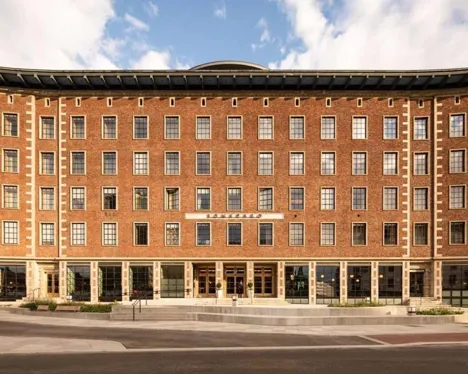
May 12: Oslo-Longyearbyen, Svalbard, by morning flight
Monday (Approximate temperature: minus 8 degrees Celsius high and minus 6 degrees Celsius low)
We depart for Oslo Gardermoen airport for the flight to Longyearbyen in the morning after breakfast.
A Polar Quest representative will meet the group on arrival in Longyearbyen and transfer everyone to the Radisson Blu hotel for check-in. The rest of the day is at your leisure.
Waterproof boots can be hired today from the renting agency.
For dinner, everyone is on their own, and you can eat at the hotel or book either of the two local restaurants recommended, which even serve reindeer steaks and salmon, of course.
Hotel: Radisson Blu Polar Hotel, Road 229-3, 9171 Longyearbyen, Norway
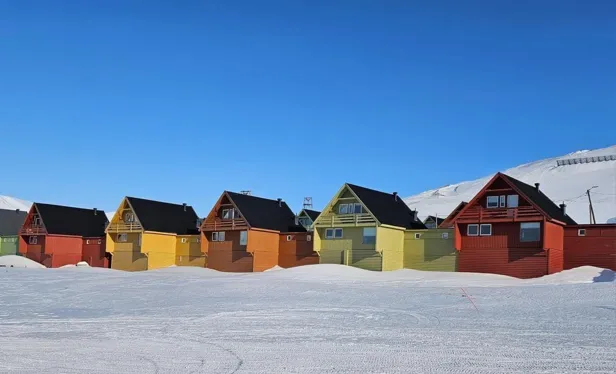
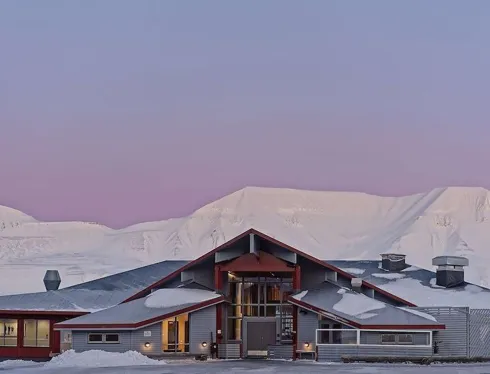
May 13, Longyearbyen: transfer to the Polar Quest ship
Tuesday (Temperatures expected from minus 10 degrees Celsius low to 0 degrees Celsius high.)
0700–1000 hours: Breakfast is at the hotel’s Radisson Blu restaurant.
1100 hours: Check out from the Radisson Blu Polar Hotel.
We will visit the Svalbard Museum, which collects, preserves, disseminates, and conducts research related to culture and natural history, the environment, and cultural heritage. In 1981, the museum was opened to the public for the first time.
1300 hours: We return to the hotel Radisson Blu Polar for lunch at the Restaurant Nansen, which serves Nordic fusion concept meals.
After lunch, we proceed in a bus to the pier in expedition gear to board the Zodiacs and embark on the ship.
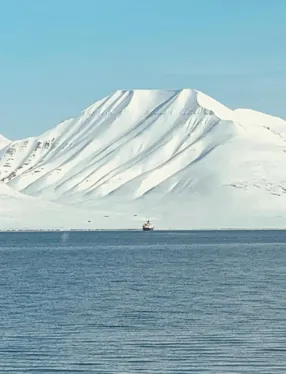
TEMPERATURE INSIDE THE SHIP
Approximately 22 degrees Celsius (71 degrees Fahrenheit).

Cabin category
Triple cabins, upper and lower beds
[306, 312]
Twin cabin, 2 twin beds
[303, 305, 307, 309, 311, 315, 314, 316, 318, 321, 323, 325, 327]
Twin cabin plus 2 twin beds
[302, 304]
Double cabin, double bed
[320, 329]
Double cabin superior Large double bed
[301, 317, 319, 402]
Owner’s cabin, large double bed
[401]
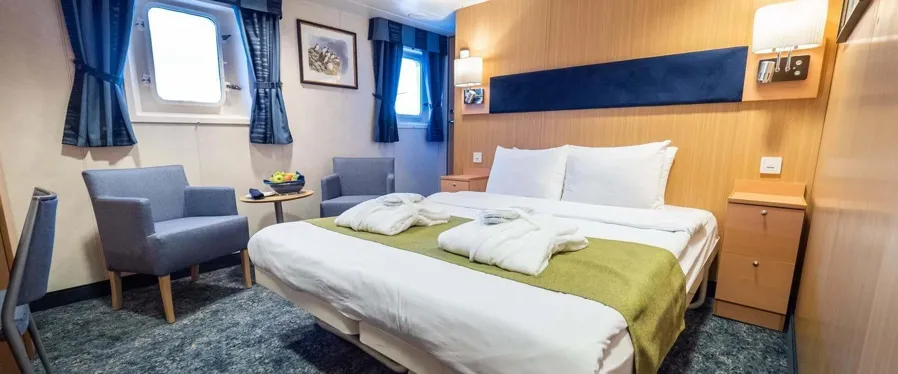
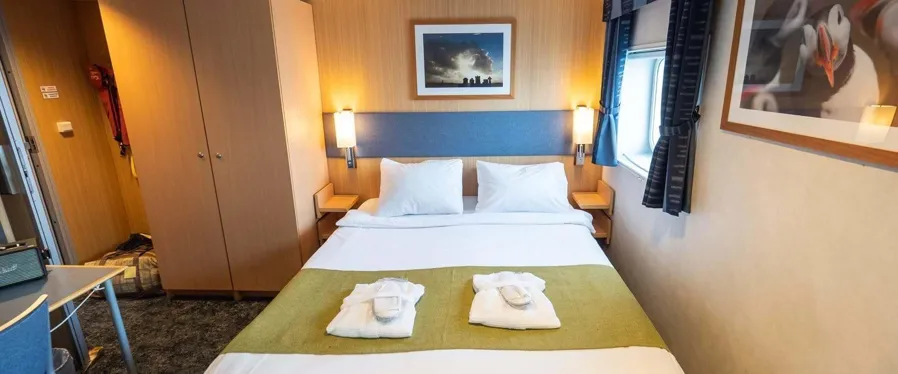
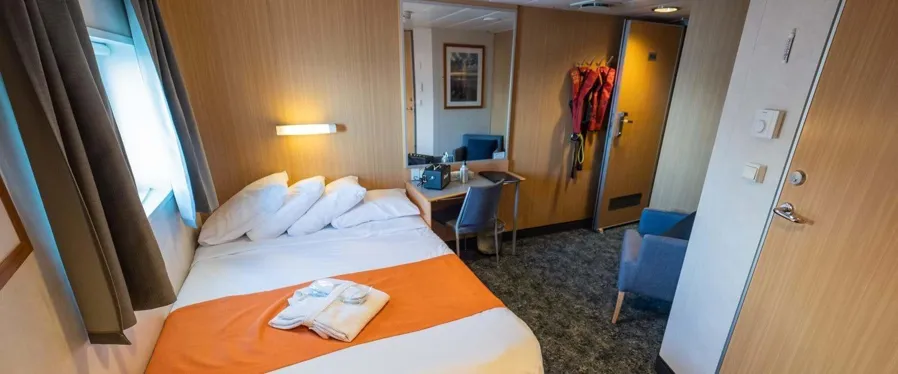
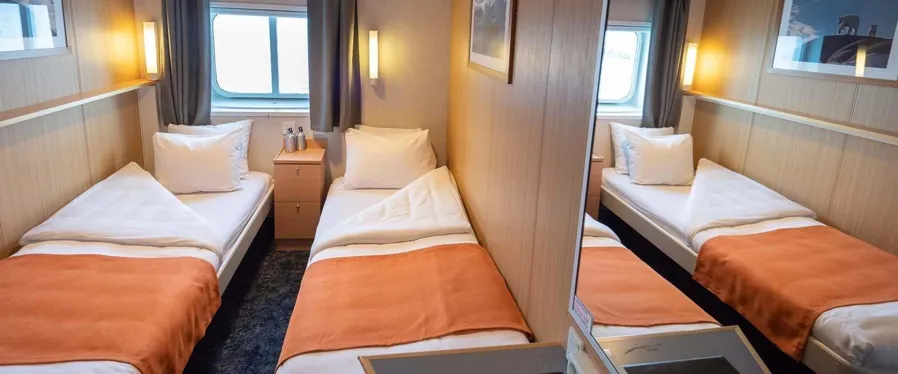
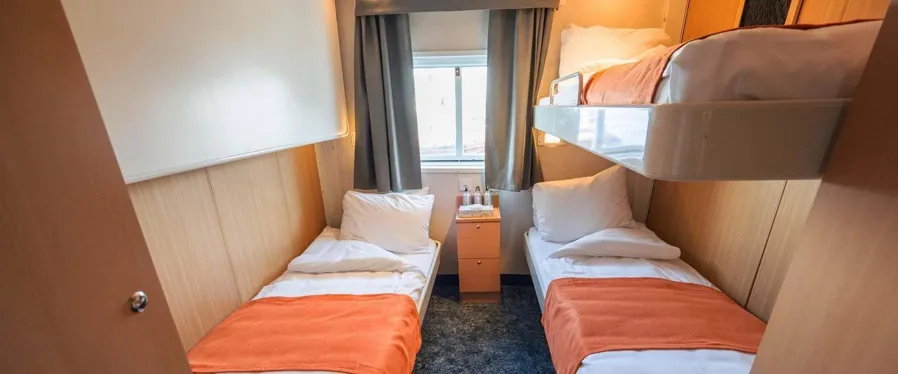
Inclusions
1 night in an Oslo hotel on May 11, 2025, on a room-sharing basis as per cabin configuration at Sommerro House. Museum visit in coach with entrance fees on May 11, 2025.
Welcome Dinner on 11th May at Sommerro House.
Breakfast on May 12 at Sommerro House.
One airport transfer in Oslo from the hotel to the airport on May 12, 2025, in one coach.
1 night in the Radisson Blue Polar hotel in Longyearbyen as per ship cabin configuration on May 12th, without lunch or Dinner.
Breakfast and Lunch on May 13 at Longyearbyen at Radisson Blu Polar
A guided visit to the Svalbard Museum on May 13 in the afternoon.
7 nights on board M/S Quest, 13th–20th May 2025, with all meals starting with dinner on the 13th and ending with breakfast on the 20th.
Welcome dinner on the 13th on board the ship.
Coffee (cappuccino/espresso), tea, and hot chocolate are available 24 hours a day, seven days a week.
An experienced Expedition leader and five knowledgeable guides. All Zodiac excursions and activities from the ship.
Comprehensive information material and consultation with Ibex before the expedition cruise
an Insulated wind and waterproof one-piece polar suit for the duration of the cruise.
The cruise journey is climate-compensated.
Flights to/from Longyearbyen on May 12 and 20, 2025 (quoted above but subject to change)
Himraj Soin, an experienced adventure expert from Ibex Expeditions, provides overall coordination, gear, and safety advice.
Coordination by Ibex Expeditions P. Ltd.
Exclusions
International air tickets.
Schengen tourist visa.
Travel cancellation, medical, and evacuation insurance.
Arrival transfer in Oslo to the hotel on May 15 or earlier.
Additional hotel nights in Oslo prior to May 15.
Personal expenses such as bar and shop charges.
Customary gratuity to the ship’s guides and crew.
Personal expenses such as bar and shop charges.
Meals are not included in Oslo except the welcome dinner on May 15 and breakfast on May 16.
Boots hiring charges.
Satellite phone charges on board the ship.
Lunch and Dinner on May 16th en route and in Longyearbyen.
Phone cards that can be bought on board.
All personal gear and equipment.
Waterproof knee-high boots hiring charges.
Any services after arrival in Oslo airport from the return flight from Longyearbyen on May 24.
PLEASE NOTE: Do let Ibex Expeditions know of any medical conditions, allergies, and food
preferences.
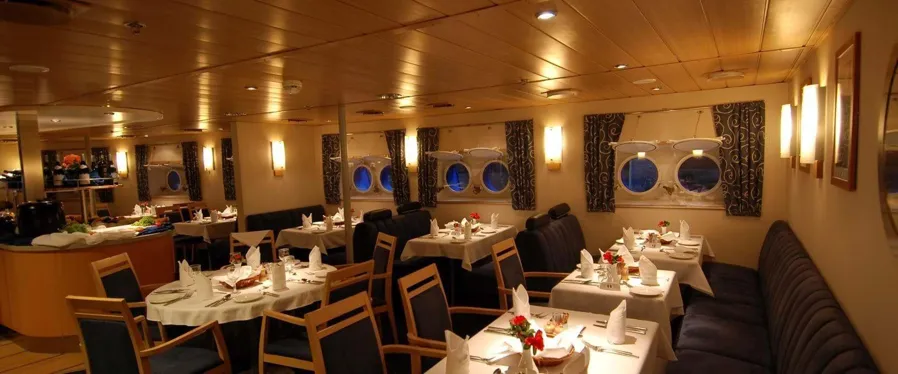
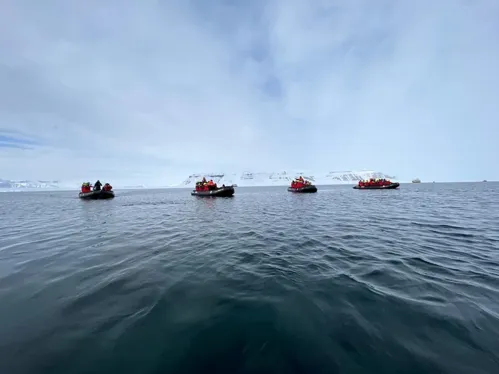
11–20 May: Today, we head out through Isfjorden on our Arctic adventure.
Sunday-Tuesday
These are places we may visit, depending on the weather and the route.
For the next week, this is the time flow for each day (approximately, as it will depend on the weather, snow and ice conditions, and wildlife spotting).
As we are travelling in mid-May, when the Arctic winter landscape is stunning with a high chance of Polar bear sightings, it may happen due to snow conditions that some days we may not have landings and it will be Zodiac-based excursions.
0800–0845 hours Breakfast
0900 hours Depart from the ship. 0900–1130/1200 hrs. Zodiac excursion.
1230 hours Lunch on board.
1430–1630 or 1700 hrs. Zodiac excursion.
1845 hours Recap/lecture on board.
1930 hours Dinner
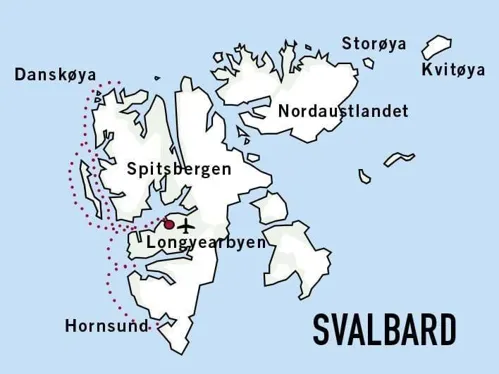
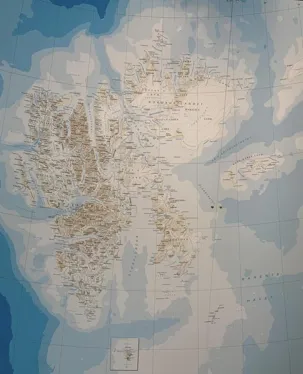
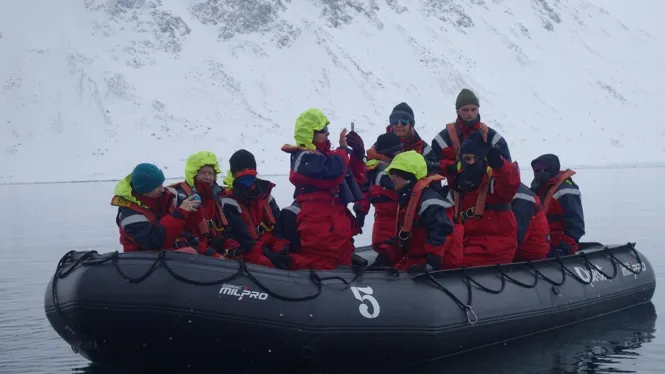
Alkhornet
At the entrance of Isfjorden is the characteristic cliff, Alkhornet. Enjoy the beautiful tundra and its birdlife with barnacle geese, Brünnich’s guillemots, glaucous gulls, snow buntings, and tens of thousands of kittiwakes. Arctic foxes are seen in the rock crevices around the mountain.
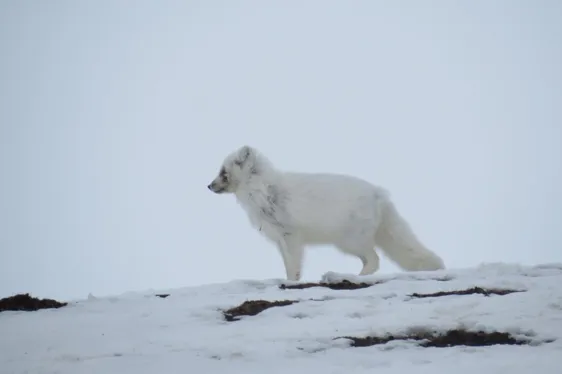
Prins Karls Forland
This narrow strip of land is covered by a magnificent snow-covered mountain chain. The island is also home to seabirds and harbour seals.
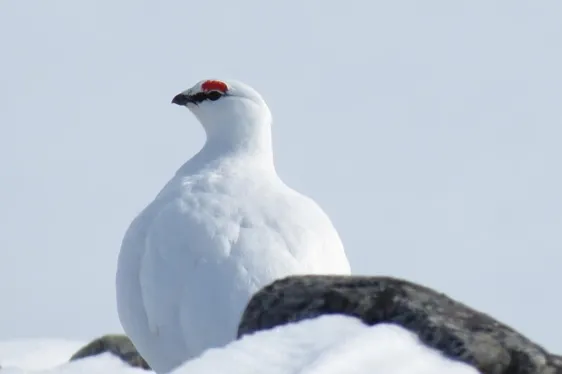
Kongsfjorden and Krossfjorden
The scientific village of Ny-lesund is situated in Kongsfjorden. It was from here that Amundsen and Nobile started their heroic expeditions to the North Pole. In the nearby Krossfjorden, we revel in the beautifully sculptured front of the 14th of July Glacier to the raucous greeting of the considerable number of kittiwakes and Brünnich’s guillemots nesting on the nearby cliffs.
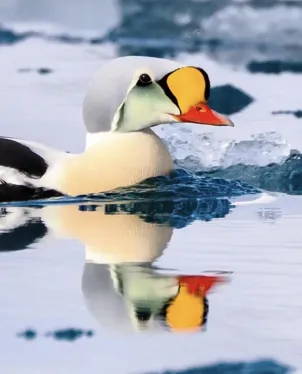
Raudfjorden
Raudfjorden is an area of immense natural beauty, dominated by beautiful glaciers. It is also a favourite spot for seals, and the bird cliffs are bursting with activity.
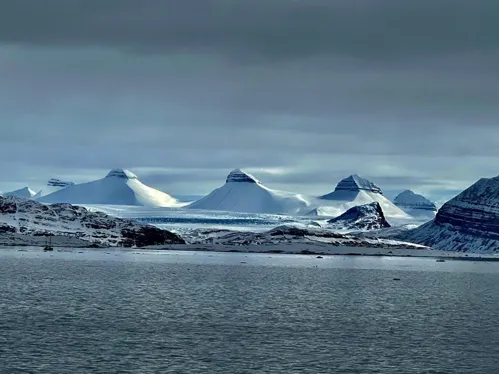
Virgohamna, Danskøya
Two of the most courageous attempts to reach the North Pole started on the island of Danskya. Swedish explorer Andrée tried with a hydrogen balloon, and American journalist Wellman started with an airship. There are still interesting remnants from these Arctic expeditions left on this site.
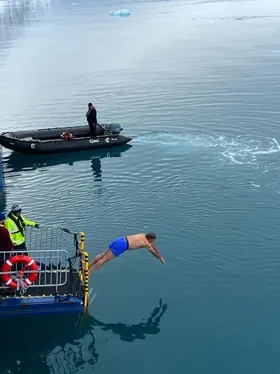
POLAR PLUNGE
The Polar Plunge is a fearsome rite of passage for visitors to the Arctic. All participants wear tethered harnesses and plunge into the icy polar waters from the gangplank, cheered on by fellow passengers.
Those wishing to undertake this iconic polar activity, which entails jumping into the icy waters under supervision from the ship on a designated ‘good weather ’ day, You must bring swimwear and courage!
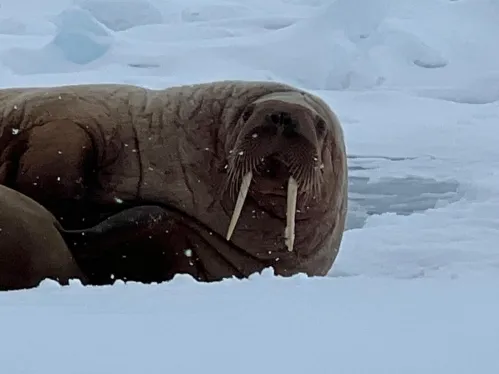
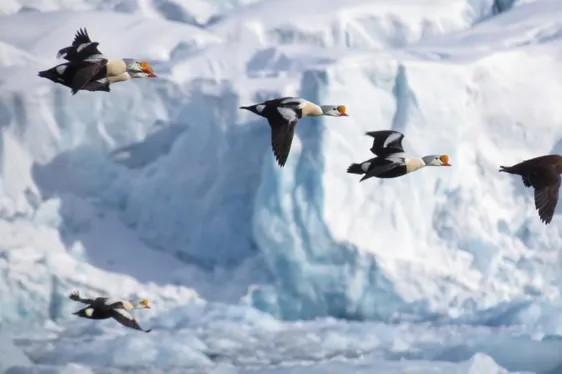
Bellsund
At the beautiful Vrsolbukta in Bellsund, little auks’ nest by the tens of thousands. We go ashore and walk across the tundra to take a closer look at these charming birds.
Hornsund
The majestic Hornsund consists of magnificent fjords along the west coast of Spitsbergen, where enormous glaciers calve out shimmering blue ice. This is one of the favourite haunts for Svalbard’s polar bears, and if we’re lucky, we can spot one of them on the fjord ice.
Polar bear
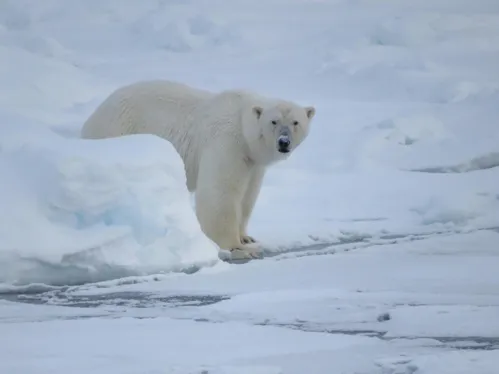
Snowshoeing
For the active, there is a chance to explore the areas we visit with snowshoes. This is an extra option that requires a proficient level of fitness. Please note that this activity is always dependent on weather, wind, and other safety precautions. The ship will have snowshoes to get into it.
By the 24th of May evening, our ship will return to the pier by late evening or night.
Please note: Our exact route will depend on ice, weather conditions, and wildlife. The places mentioned are just examples of the sites Svalbard has to offer. Polar Quest always strives to maximize our experience. Please remember that flexibility is the key to a successful expedition!
May 24: Longyearbyen to Oslo
We will have an early breakfast at 0700 hours and between 0800 – 0830 hours, we will depart for the town by bus where all of us will be free to explore shops or cafes for last-minute souvenirs before leaving for the airport at around midday.
Our return flight to Oslo will be in the afternoon (TBD after 2024 flight schedules are announced) in a 2 hours 55 minutes nonstop flight duration.
A snack of sandwiches may be bought on the flight, but it is recommended to have this packed from a local café called Café Huskies.
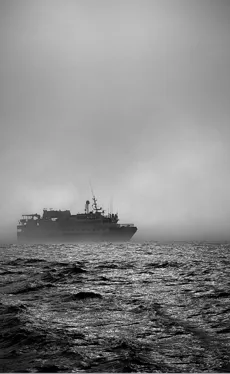
ABOUT THE SHIP
The ship was built in Denmark in 1992 to serve as a ferry on Greenland’s west coast. In 2004/2005 and was refurbished into a comfortable expedition ship and in 2018 she underwent a renovation of the passenger areas. The ship takes 53 passengers, and all 26 cabins are outside cabins with private facilities.
The triple cabins have upper and lower berths. All other cabins have two lower berths or a double bed. In your cabin, you will find a desk with a chair and a cupboard for storage. The superior cabins are spacious and have armchairs and a TV. The owner’s cabin has a double bed, two large picture windows, a separate seating area and a TV.
In the dining room, we will enjoy delicious meals in between landings and in the panorama lounge, we will enjoy breath-taking views of the surrounding landscape. Here we will listen to entertaining talks on the area’s flora, fauna, and history. In the lounge, there is a bar and a small library.
The ship has spacious observation decks, where we enjoy the beautiful vistas. Passengers are welcome on the bridge around the clock and there is always something to see or search for. An international crew welcomes us onto the ship, and we have five Zodiacs and five guides on board.
Photo courtesy: Ajit Dayal, Mandip Singh Soin, Himraj Soin, Yasho Saboo, Philip Hammick, Rahul Verghese, Vivek Srivastava, Vide Brandt.
The magical midnight Sun.
The eternal sun, polar day – the midnight sun is known by many names.
Regardless of what you choose to call this natural phenomenon, it is a unique experience to visit Svalbard during the summer months when the days never end. Most people know about the midnight sun, but do you really know what causes the phenomenon?
In Svalbard, the sun does not set between mid-April and the end of August. During this period, the North Pole faces the sun and the further north you are from the Arctic Circle, the longer the midnight sun shines. The Earth’s axis is tilted at an angle of approximately 23°, which means that the sun does not
The magical midnight Sun.
The eternal sun, polar day – the midnight sun is known by many names.
Regardless of what you choose to call this natural phenomenon, it is a unique experience to visit Svalbard during the summer months when the days never end. Most people know about the midnight sun, but do you really know what causes the phenomenon?
In Svalbard, the sun does not set between mid-April and the end of August. During this period, the North Pole faces the sun and the further north you are from the Arctic Circle, the longer the midnight sun shines. The Earth’s axis is tilted at an angle of approximately 23°, which means that the sun does not
The magical midnight Sun.
The eternal sun, polar day – the midnight sun is known by many names.
Regardless of what you choose to call this natural phenomenon, it is a unique experience to visit Svalbard during the summer months when the days never end. Most people know about the midnight sun, but do you really know what causes the phenomenon?
In Svalbard, the sun does not set between mid-April and the end of August. During this period, the North Pole faces the sun and the further north you are from the Arctic Circle, the longer the midnight sun shines. The Earth’s axis is tilted at an angle of approximately 23°, which means that the sun does not
The magical midnight Sun.
The eternal sun, polar day – the midnight sun is known by many names.
Regardless of what you choose to call this natural phenomenon, it is a unique experience to visit Svalbard during the summer months when the days never end. Most people know about the midnight sun, but do you really know what causes the phenomenon?
In Svalbard, the sun does not set between mid-April and the end of August. During this period, the North Pole faces the sun and the further north you are from the Arctic Circle, the longer the midnight sun shines. The Earth’s axis is tilted at an angle of approximately 23°, which means that the sun does not disappear below the horizon if you are at high latitudes. In Svalbard, this means exposure to the sun around the clock. When the Earth’s axis tilts the other way during the winter months, everything north of the Arctic Circle is hidden from
the sun’s rays. You then talk about polar night or midwinter darkness.
The perfect light
Many who have experienced the midnight sun describe the phenomenon as a golden shimmer. This combined with the Arctic silence is something truly special to experience. The light from the midnight sun can be compared to the “golden hour”, the time just before or just after sunset, something that many photographers consider provides the perfect conditions. This also offers the perfect opportunity for capturing unforgettable photos!
Day and night flow together
It can be difficult to keep track of time when day and night flow together. The bright nights trigger us to stay up and enjoy everything that the dreamlike Arctic landscape has to offer. Many locals get an extra boost of energy during these months when the sun is constantly above the horizon and like to stay awake into the wee hours. As a visitor, it is important to use blackouts or eye masks to get the necessary sleep even though the magical light calls for attention!
TRAVEL RESPONSIBLY
The mean temperature is rising, and the glaciers are melting. Microplastics and chemicals are polluting our seas and the world needs to make an instant change. A journey through these spectacular wildernesses evokes feelings and creates memories for life. Help us to preserve it for generations to come!
Tourism holds a great responsibility when it comes to education and making observations and is one of the few businesses that gain from preserving the areas we visit. It is a necessity for our survival. We can observe both changes in the environment as well as other industries and how they act. We travel in small groups and strive to have minimal impact on the environment. Small expedition ships are the most sustainable way to explore the wildlife and nature of Svalbard.
Investing in the Environment
We cannot avoid emitting greenhouse gases and until renewable fuels are available, Polar Quest invests in projects with positive effects on nature, to be transparent with our emissions, and to do our best to reduce our emissions continuously. We have measured all our emissions from flights, overland transport, expedition cruises, meals, and hotel nights. The same philosophy is reflected by Ibex Expeditions in our journeys.
RESPONSIBLE TRAVELLER GUIDELINES ~ www.rtsoi.org
The Responsible Tourism Society of India launched the Responsible Traveller guidelines which will be a National campaign by the Ministry of Tourism, Government of India in partnership with the United Nations Environment Programme in India. We request all participants to support these guidelines.
SINGLE USE PLASTIC
One of the key points in our Responsible Traveller campaign is to carry your own steel insulated water bottle for the entire Ibex Expeditions Arctic journey.
As a responsible team, we do not use any single use plastic, the biggest destroyer of the planet. Please take a pledge to refill bottles at the Oslo and Longyearbyen hotels to minimize mineral water bottle plastic usage. We encourage all our team members to try, and carbon offset their international flights to Oslo and back.
We wish you an unforgettable journey to one of the planet’s greatest wilderness areas.
Springtime in Svalbard Artic Expedition featured on “The Straits Times, Singapore” organized by Ibex Expeditions.

FOR ITINERARY AND MORE DETAILS
Email Ibex Expeditions for details @ibex@ibexexpeditions.com
